The Soldier's Details

- Surname:
- Thorns
- First Name:
- Arthur Stanley
- Nick Name:
- Codge
- Rank:
- Private
- Regimental #:
- WX10289
- Classification:
- Driver
- Company:
- ‘B’ Company, No 7 Platoon
- Enlisted:
- 18.12.1940
- DOB:
- 18.11.1917
- Place of Birth:
- Trafalgar, Western Australia
- Father's Name:
- Albert Wilfred Sibley Thorns
- Mothers's Name:
- Amy Matilda Thorns (nee Paterson)
- Religion:
- Methodist
- Pre-war Occupation:
- Pipe Fitter
- Memorial:
- Epitaph, Labuan memorial, Panel 19, Age 27.
- Singapore:
- Selarang Camp Changi, Johore Bahru, Adam Park, Selarang Barracks Changi
- Force:
- ‘E’ Force Borneo
- POW#:
- 4/6721 & 1936
- Cause of Death:
- Beaten to Death
- Place of Death:
- Ranau No. 2 Camp
- Date of Death:
- 1.08.1945
General Description
Thorns enlisted with AIF Dec 1940 recording his father as his NOK and later joined ‘B’ Company 7 Platoon as a Driver under Commanding Officer Lt. Dean.
Codge was in good company in the 2/4th – there was a large contingency of enlistments from Kalgoorlie and the surrounding goldfields. Most were tough, resilient, skilled with their hands and enjoyed a unique Australian sense of humour.
As a POW in Singapore, Codge joined ‘E Force Borneo to work at Sandakan. None of the POWs had an inkling of what would transpire at this terrible camp beginning in 1945.
Arthur Thorns soldier was amongst the last group at Ranau to be massacred. During the War Trials of Sandakan the final conclusion regarding the POWs at Ranau was on 1st August a senior Japanese soldier gave the order to the guards to kill all remaining prisoners estimated to include 42 Australians and 7 British POWs. Locals however, reported the men’s deaths to be later. It is known ‘Codge’ Thorns was amongst the last surviving Australians and the only 2/4th soldier alive at this time, most of whom were extremely ill. He was beaten to death. He was 27 years of age.
Codge was named/identified by Lieutenant W H Sticpewich who had earlier escaped Ranau. Sticpewich was one of the only six survivors from Sandakan.
Information from ‘Sandakan – The Untold Story of the Sandakan Death Marches’ by Paul Ham.
Height 5′ 9″
Read the story of Sandakan, B and E Forces
Please read list of relics found Sandakan.
See photos of all West Australians who perished at Sandakan
Below: Good news received in Sep 1943 for Codge’s family and Ron Badock.
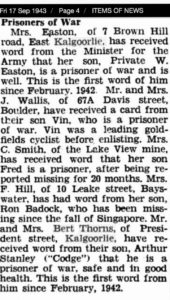
Ron Badock always referred to Codge (pronounced ‘Codgee’). – in fact he was probably known as Codgee by the boys of 2/4th.
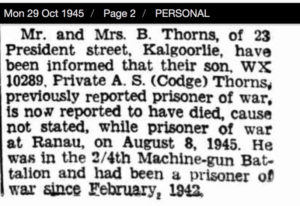
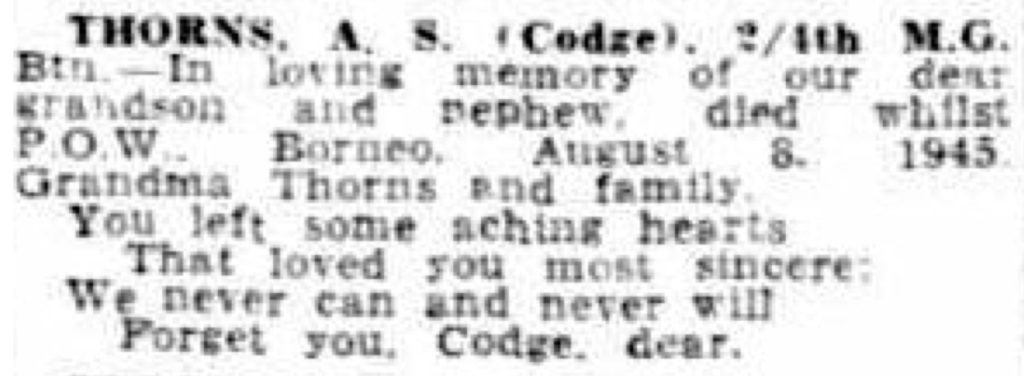
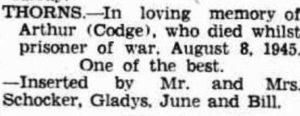
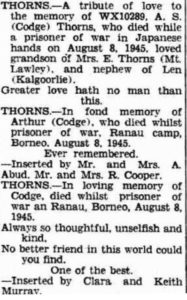
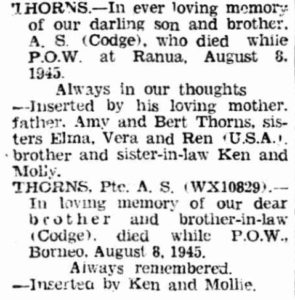
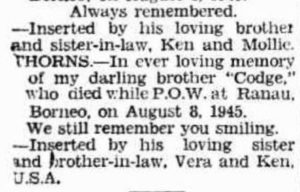
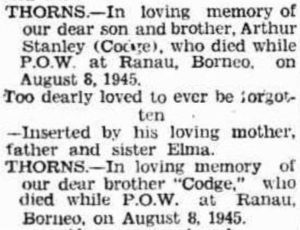

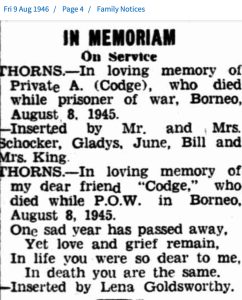
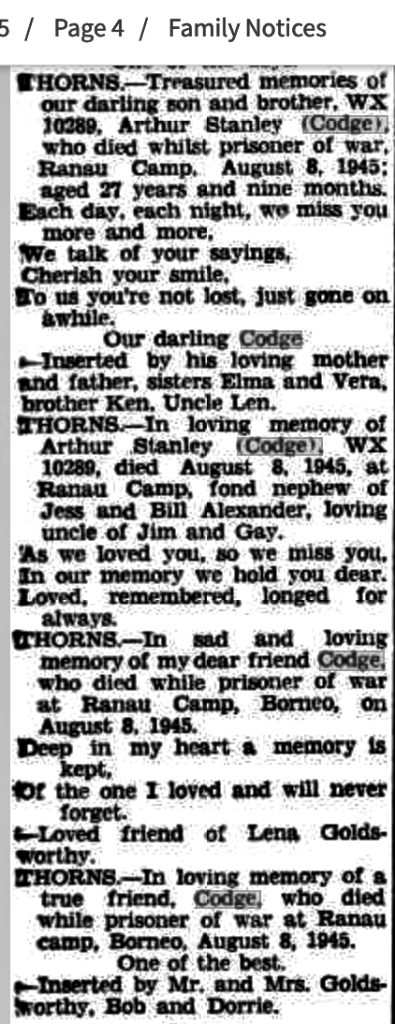
__________
Codge was the eldest of four children born to Albert ‘Bert’ Wilfred Thorns (son of Albert Thorns and Emma Sibley) and Amy Matilda (nee Paterson) who married 1917, Boulder. Codge was last recorded residing with them at 23 President Street, Kalgoorlie. Bert Thorns and his brothers were born in Gympie and moved to the WA Goldfields with their parents Emma and Albert Thorns – grandparents to Codge.
We believe Bert and Amy named their first born son Arthur Stanley after Bert’s two brothers Arthur John Vivian Thorns who died WW1 France 29 Jul 1916 and A. H. ‘Stanley’ Thorns who died in 1918 with 51st Battalion. We believe both Arthur and Stanley had served with Militia prior to enlisting.
Arthur Thorns enlisted 22 Jul 1915 into 28th Battalion.
Alfred Henry Stanley Thorns enlisted 5 Sep 1914 into 11th Battalion He was later transferred to 51st Battalion. He was awarded a MM and had been wounded on at least three occasions. Stanley fought at Gallipoli with 11th Battalion, later transferring to 51st.
Third brother George Albert (Leslie) Thorns enlisted 18 Oct 1917 into 48th Battalion. Les had his left foot severely damaged by a shell and was finally discharged 16 Mar 1918. Les was married.
All were born in Gympie.
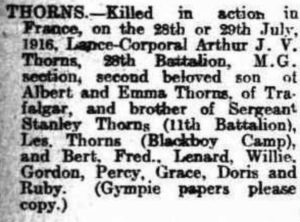
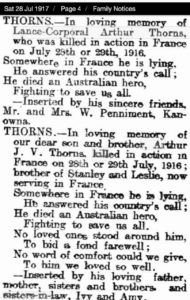
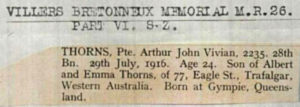
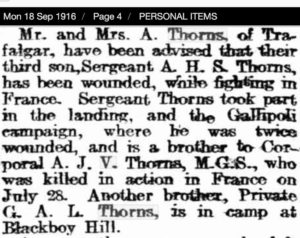
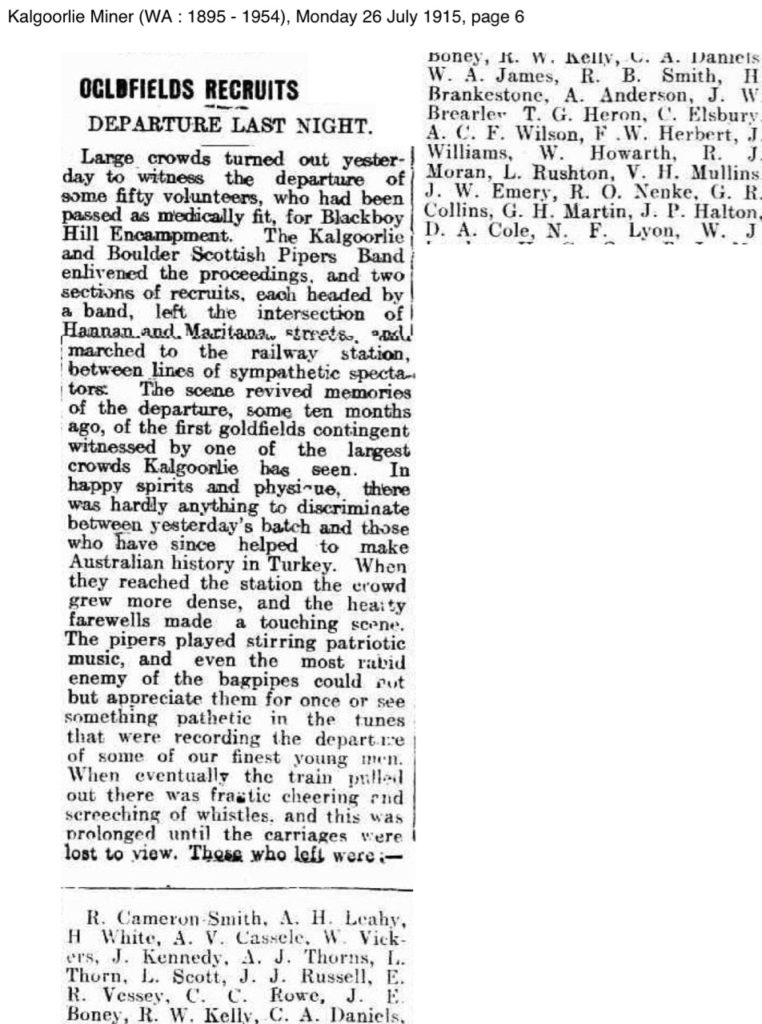
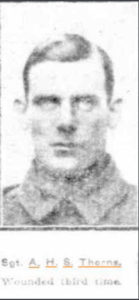
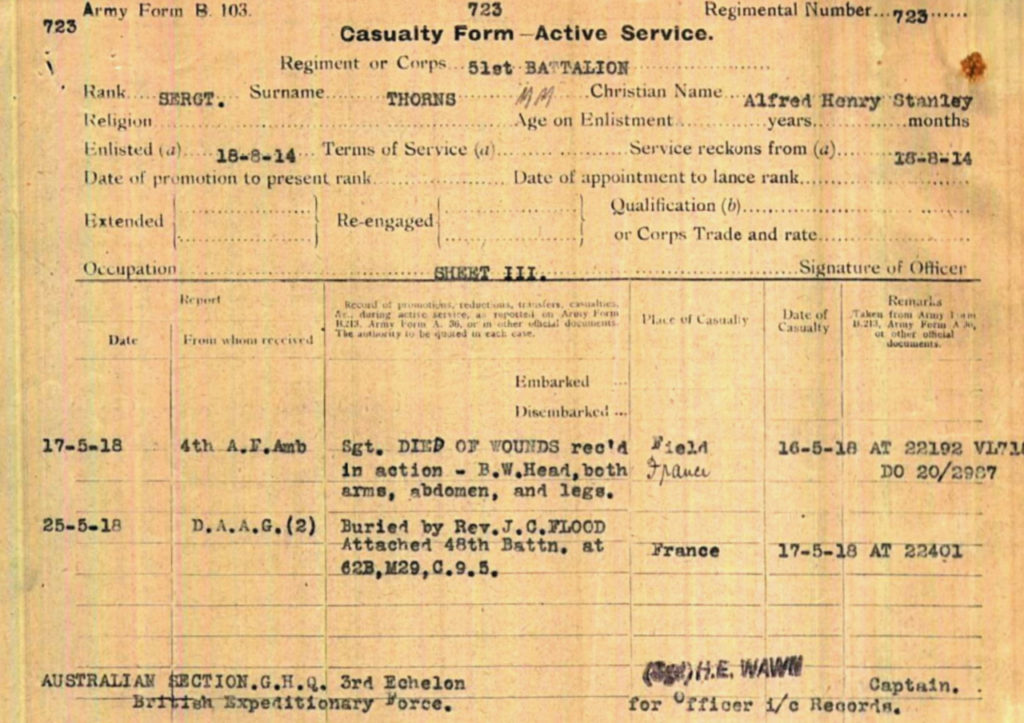
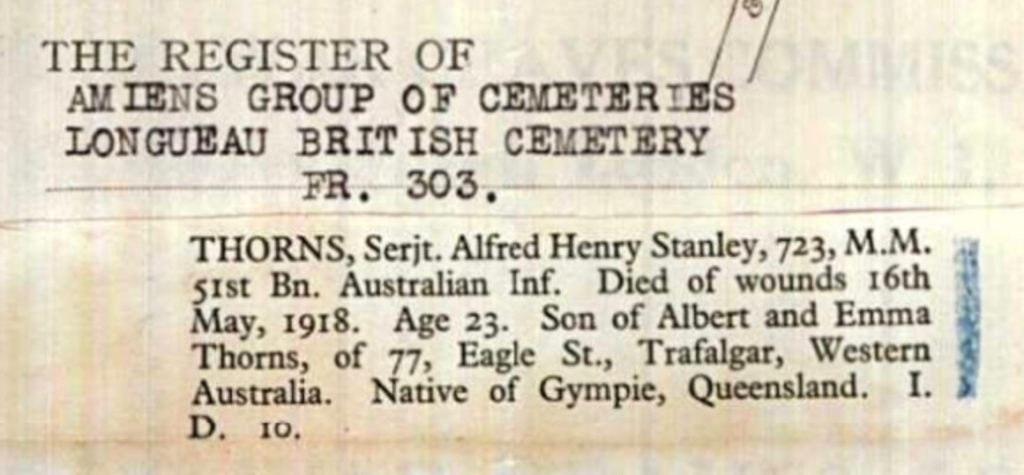
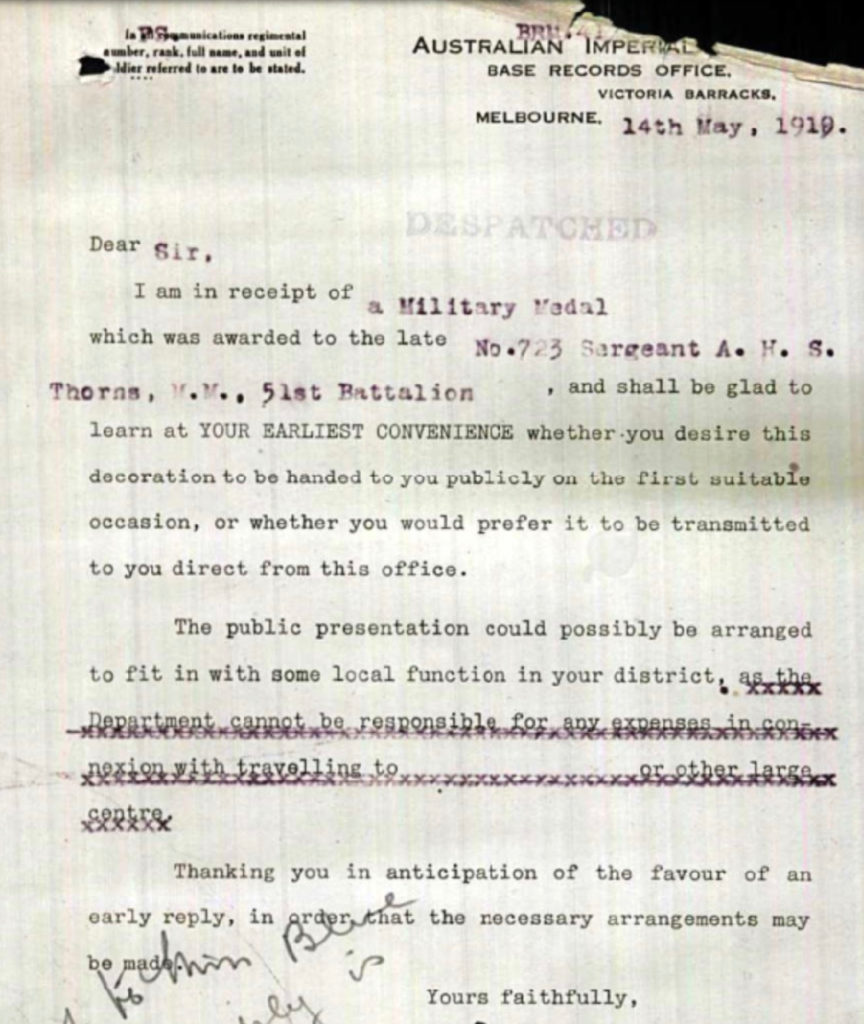
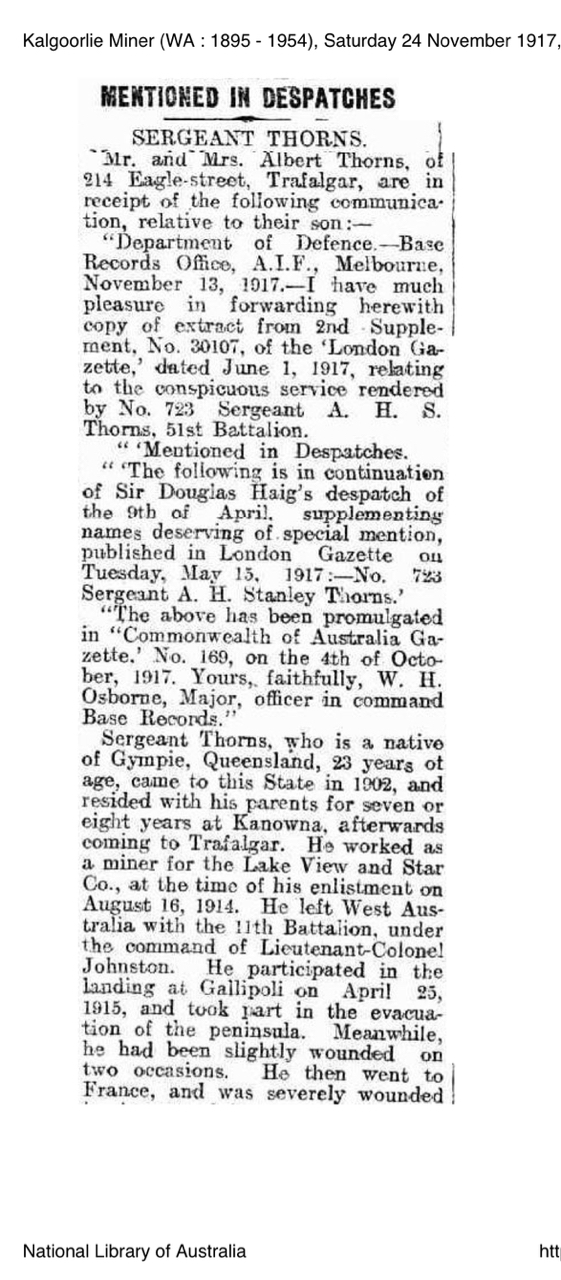
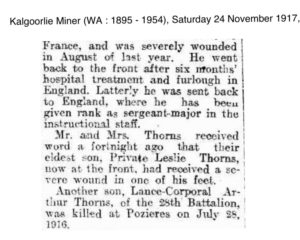
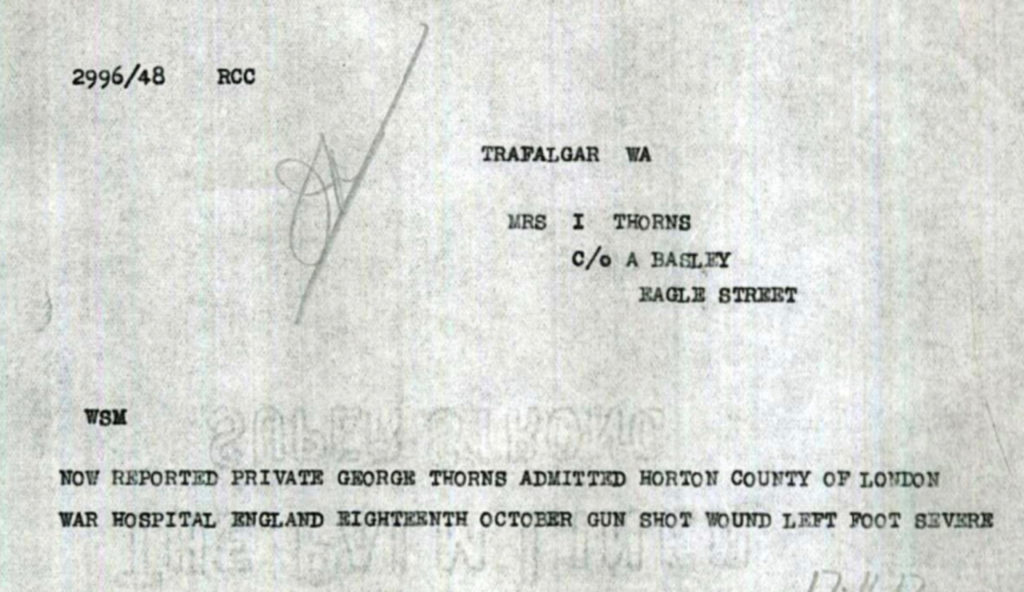
In 1932, Albert Thorns died – grandfather to ‘Codge’ and father of Stanley and Arthur John Thorns who lost their lives in WW1.
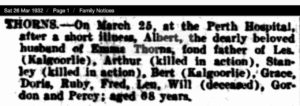

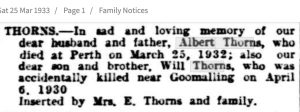
Below: Codge’s Grandmother Emma died in 1948.
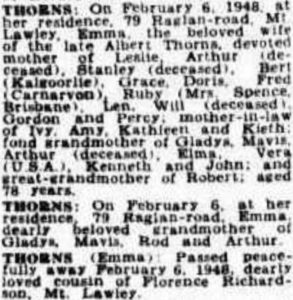
__________
Arthur or ‘Codge’ as he was known, enlisted AIF 18 Dec 1940 and later joined 2/4th MGB’s ‘B’ Company No. 7 Platoon as a Driver. This Platoon was under Commanding Officer Lt Penrod Dean.
He sailed from Singapore as a POW of Japan on 2 March 1943 for North Borneo with ‘E’ Force Borneo. E Force were accommodated at No. 3 Sandakan Compound (B Force was at No. 1 and the British at No. 2) – the Japanese forbid the compounds to communicate with each other.
Eventually B and E Force were amalgamated.
The First Death March from Sandakan to Ranau began departing in groups of approx. 50 POWs with their guards at the end of January 1945. The Japanese no longer distributed rice and POWs were forbidden to trade with locals – the repercussions were a terrible death. Codge left Sandakan with No. 2 March from Sandakan, beginning end of May 1945. Once again they departed in groups of about 50 POWs with their guards. It was at this time, the Japanese ordered all POWs out of their huts – they were the very sick unable to march. Some hobbled, others crawled and some were carried by mates to lie out in the open of the compound many without shelter, some had their ground sheets and all dressed in a few rags. All the POW huts were then set on fire by the Japanese and who also began burning all documents.
Codge miraculously made it to Ranau – when so many died on the track. There were 71 boys from 2/4th at Sandakan.
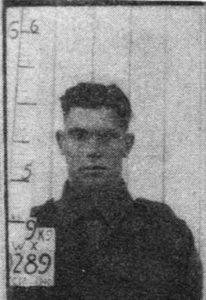
-
WA. Paybook photograph, taken on enlistment, of WX10289 Private Arthur Stanley Thorns, 2/4th Machine Gun Battalion, Australian Infantry. He was one of over 2000 Allied prisoners of war (POW) held in the Sandakan POW camp in north Borneo, having been transferred there from Singapore as a part of E Force. The 500 Australian and 500 British POW’s who made up E Force, left Changi on 28 March 1943, on board the S.S. DeKlerk arriving at Berhala Island (adjacent to Sandakan Harbour) on 15 April 1943. The POW’s were held there until 5 June, when they were taken by barge to Sandakan. The next day they were transferred to the 8 Mile Camp, which was about half a mile from the B Force compound. Private Thorns, aged 27, died as a prisoner of the Japanese on 8 August 1945. He was the son of Albert Wilfred and Amy Matilda Thorns, of Kalgoorlie, WA. He is commemorated on the Labuan Memorial Panel 19. (Photograph copied from AWM232, items 4 and 5. Personal information from the Commonwealth War Graves Commission Database.)
Amy Matilda Paterson was one of two daughters born to ALBERT HENRY ‘PATTY’ PATERSON.
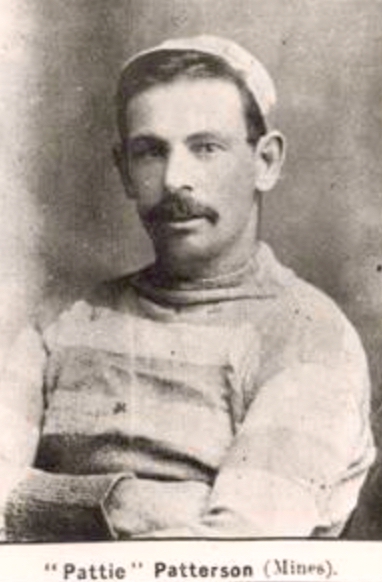
Ballarat & District in the Great War
Paterson became known as Carlton’s “lost soldier”, when his name slipped through the naming of the club’s Great Fallen. He was Alby Paterson, from Happy Valley.
When Albert Henry Paterson was born on 4 March 1875, Happy Valley had a population of just over 500 people. The Woady Yaloak gold diggings, 28 kilometres from Ballarat, extended from Linton to Pitfield and Happy Valley – named because of the large yields – continued to be mined into the early 1900’s.
Alby’s Scottish father, Thomas Paterson, worked as a gardener after the gold ran out. His mother, Jane Hughes was a Smythesdale girl and she presented Thomas with twelve children, of which Alby was the seventh, before her death on 6 March 1893.
The school where Alby would have received his education was initially called the Lucky Lady after one of the local mines, but by the time he attended had been given full status as the Happy Valley State School.
During these years Happy Valley had grown large enough to incorporate a post office, a police station and bank – plus, of course, the ubiquitous pubs and churches to deal with the sinners and saints.
With gold still being mined around Happy Valley, it was inevitable that Alby would take to mining as a living. But he also had a rather special ability as a footballer – and it was good enough to warrant him leaving his home-town for the “bright lights” of Melbourne to play for the Ascot Vale Football Club.
It wasn’t long before Alby’s high-marking defending caught the attention of scouts from the Carlton Football Club, who were then playing in the Victorian Football Association. He was recruited for the 1892 season and turned out for Carlton in the VFA until the end of 1896.
With the emergence of the new Victorian Football League in 1897, eight clubs began a journey that would see Australian Rules develop into a national sport. Carlton was one of those clubs. The second match of the season was against South Melbourne at the Lakeside Oval, and Alby “Pattie” Paterson turned out in the pivot position. It was to be his one and only game of VFL football.
That same year he married Sarah Elizabeth Gazzard. Sarah was born at Durham Lead in 1877, but grew up in Carisbrook and that is where the couple were married at the local Methodist Church.
It seems that marriage prompted Alby to leave the Carlton Football Club and settle in Carisbrook with his new wife. It was there that their first two children were born – Amy Matilda in 1898 and Laura May in 1900.
Like many families during the 1890’s economic depression, the Patersons chose to pursue a more lucrative future on the West Australian goldfields. By 1898, with the discovery of rich deep lead gold deposits, Kalgoorlie was booming and the big mining companies offered immediate long-term employment for those men who were prepared to take on the back-breaking work.
Alby and Sarah settled in the new area of Trafalgar (also known periodically as Lake View) just four miles from the township of Boulder. It was with the Boulder Mines Rovers that Alby was to continue his football career.
In 1901 he was a member of the Goldfields representative team that played in a series of “test matches” in Perth. Collingwood great, Ted Rowell, whose early football career was with the Goldfields League, later said of Alby Paterson: ‘ . . . [He was] an almost unbeatable half-back. Although not very tall he had a wonderful spring and judgment, he was a splendid high mark…’
In 1902, Sarah gave birth to the couple’s first son, Albert Thomas, but, sadly, he was only 18-months old when he died the following year. A second son, Albert Edward, was born in 1904, but he, too, was to die when still just an infant of 8-months.
Through the grief, Alby continued to play football. He had been selected to represent Western Australia in the Interstate Carnival in 1904, but he was unable to travel to Victoria due to the death of his son.
He finally got his chance when he was again selected to represent WA in the Interstate Carnival of 1906. By this stage, Alby was coming to the end of his playing career, but he had earned a reputation as a footballer that was not easily forgotten,
‘…“Patty”, as he was familiarly known on the fields, was generally regarded as the finest exponent of the game as a back player in goldfields league football, his brilliant and safe high marking being quite features of the matches in which he took part in the early years of this century. On the field he was absolutely clean and fair to an opponent, and was undoubtedly one of the most popular players…’
The birth of the couple’s third son, Kenneth, in 1907, must have been both a source of great joy and fear. However, this little boy thrived. Then, in 1911, their family was completed with the birth of their final child, Jessie.
Alby continued working in the district mines in the years leading up to the war. He was also an active member of the Trafalgar Fire Brigade and the National Labour Party. Life was full.
The call for experienced miners to reinforce the specialist Tunnelling Companies, resulted in Alby enlisting at Kalgoorlie on 31 December 1916. His medical examination was conducted the same day, but, for some reason, he did not take his oath until much later.
The medical officer, who recorded Alby’s details, noted that he was 5-feet 7-inches tall, but weighed a substantial 12-stone 8-pounds and had a massive chest that, when expanded, measured 41-inches. Despite being 42 years old, Alby’s eyesight was perfect, and the hot West Australian sun had failed to darken his fair complexion. The doctor noted that he had a scar on the left side of his upper lip, and you are immediately left wondering if it had been received on the football field or in the mines… His hazel eyes and brown hair completed the picture of the new recruit.
Before leaving for camp in Victoria, Alby made sure that Sarah and the children were well provided for – he allotted four-fifths of his pay to them, which amounted to five-shillings a day.
Alby had no previous military training, but he wasn’t being employed to wield a rifle and bayonet. His expertise was going to be underground. He was posted as a sapper with the tunnellers on 16 February 1917, and continued his training at Seymour and Ascot Vale Camps.
On 4 August 1917, Alby boarded the troopship Themistocles at Melbourne for the voyage to the United Kingdom. Given the increased enemy U-boat activity around the English coast, the Themistocles made for the port of Glasgow, Scotland, instead. The trip took nearly nine weeks before they finally docked on 2 October.
The following day, Alby marched into the Parkhouse Camp – one of the many specially created facilities on the Salisbury Plain for the thousands of troops constantly moving through the training depots.
It was a quick turn-around, and on 14 November, Alby was on his way to France. After just a few days in the Australian General Base Depot at Rouelles, he was moved to the 1st ANZAC Command Depot and attached for duty with the 3rd Pioneer Battalion.
When Alby joined the 3rd Tunnelling Company on 15 January 1918, the unit was working on multiple tunnels at Vermelles near Hill 70, however, by this time enemy mining activity had slowed, so the area was relatively quiet.
Still, the tunnellers had very specific work to carry out,
‘…Each tunnelling unit was occupied in offensive and defensive mining which involved the placing and maintaining of mines under enemy lines, as well as other underground work such as the construction of deep dugouts for troop accommodation, the digging of subways, saps (a narrow trench dug to approach enemy trenches), cable trenches and underground chambers for signals and medical services…’
The 1st Australian Tunnelling Company went to Ypres and went on to relieve the Canadians at Hill 60. The 2nd Australian Tunnelling Company went to Neuville St Vaast and then moved to Nieuport to construct subways for Operation Hush. The 3rd Australian Tunnelling Company went to the Fauquissart area and took over chalk workings at Hill 70.
After serving continuously for over six months, Alby finally succumbed to illness on 31 July 1918. He was admitted to the 73rd Field Ambulance suffering from a fever. After being assessed, he was transferred to the 1st Casualty Clearing Station.
After a week, Alby’s condition had worsened and he was transferred to the 30th Casualty Clearing Station suffering from pleurisy. Influenza was also mentioned as they attempted to work out what was behind the infection that was proving so difficult to relieve.
On 18 August, Alby was transferred to the 22nd General Hospital at Camiers, before spending a short time in a nearby convalescent depot. He was finally discharged from hospital on 9 September, but it was obvious that whatever the underlying cause, it had not been cured. Just ten days later he was back in hospital – the 2nd General Hospital at Le Havre. This time, the diagnosis was lobar pneumonia and he was evacuated to England. He was admitted to the Bath War Hospital on 28 September. The illness was taking its toll – Alby was losing weight and his heart was being compromised.
When the Armistice was signed and the war came to an end, Alby had spent nearly two months in the Bath War Hospital. He was transferred to the 3rd Australian Auxiliary Hospital at Dartford on 15 November, but was soon discharged to furlough.
It was clear to the consulting military doctors that Alby Paterson’s health was now compromised and they made immediate preparations for him to be repatriated to Australia. It was possible that they hoped the warmer, cleaner air of Western Australia would help with his recovery. He sailed for home onboard the transport Mamari on 21 December.
On arriving back in Fremantle, Alby was admitted to the No 8 Australian General Hospital, where he was assessed more thoroughly. They noted that his heart was dilated and he was suffering from tachycardia. By that stage, he had lost 2-stone in weight.
In early February 1919, regardless of the fact that Alby felt like he was improving, he was still coughing and was suffering some problems with his breathing. The doctors, nevertheless, felt that the disability was not permanent – they marked him as suffering a 40% reduction in fitness for work and believed that he would probably be fully recovered in another six months. They maintained that the condition was caused by stress and strain of service.
When he was discharged from the AIF on 2 March 1919, he was recorded as being medically unfit.
A “Welcome Home” social was held at the Mechanics’ Institute in Trafalgar on 15 May – amongst the “boys” welcomed was Alby Paterson. After a community concert and ‘a dainty supper’, the room was cleared and ‘dancing was indulged in till a late hour.’
Obviously, the damage to Alby’s health was permanent, in spite of the doctor’s considered prognosis. Without every fully recovering, Alby died at Trafalgar on 16 April 1920. Obituaries appeared in Western Australian newspapers under the headline, “Prominent Footballer’s Death” and the funeral at the Kalgoorlie Cemetery was a sad and solemn occasion. But there was no mention of the cause of his demise.
When notices appeared in the local newspapers on the first anniversary of Alby’s death, the family included the words, “died…from gas poisoning.” Certainly, the ever-present threat of gas attacks was something most members of the AIF were exposed to – and for the tunnellers there was also the added risk of foul air underground. Although there was no mention of gas poisoning in Alby’s service record, the Defence Department immediately accepted that his death was due to war service and his name was added to the Nation’s Roll of Honour.
The Second World War was going to bring further tragedy to the family of Alby and Sarah Paterson, with the death of their grandson, Private Arthur Thorns – son of their daughter, Amy. He had been taken prisoner of war by the Japanese on the island of Borneo and died on 8 August 1945 during the final Sandakan death march. The Japanese Empire surrendered just a week later.
Sarah Paterson was to live through all this heartbreak. She died at East Coolgardie in August 1961, having spent over 40 years as a widow. On 11 August she was buried with Alby in the Kalgoorlie Cemetery.
In early 2016, the Carlton Football Club, after being contacted by a Paterson family member, was finally able to clear up the mystery of the “missing footballer”. Alby’s name had been recorded incorrectly as Patterson and, consequently, no corresponding records could be found. He became the twelfth footballer from the club to be remembered as having made the ultimate sacrifice in the Great War.
© Amanda Bentley 2019
We acknowledge and are most grateful to Amanda Bentley for her work and the detailed information about Codge Thorn’s grandfather.
‘This story was published by amandabentley62 He enlisted in the Australian army in December 1916 and was transported to France to join the 3rd Australian Tunnelling Company during World War I. He contacted pneumonia on 1918 and was discharged from the army in 1919 due to being medically unfit to serve. He died from gas poisoning in April 1920′
Paterson was 46 years old and buried at the Kalgoorlie Cemetery. When his wife Sarah died in 1961 she was buried with Alby.

Below: From ‘Western Argus’ 19 April 1921

Camp Locations:
- Johore Bahru, - Malaysia
- Selarang Camp Changi - Singapore
- Ranau - Borneo




